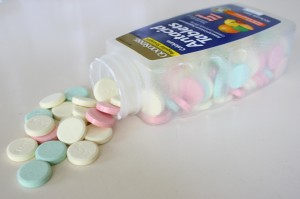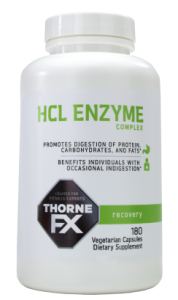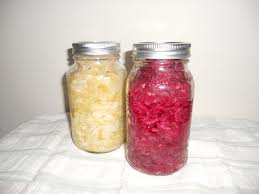Have you been feeling a little out of sorts lately? While there could be a laundry list of causes, the solution may be a little more common than you think – Low stomach acid. Low stomach acid (also known as hydrochloric acid) is an incredibly common issue that actually affects up to 90% of us and comes with a laundry list of symptoms, including:
- Acne
- Eczema
- Keratosis Pilaris (chicken skin)
- Psoriasis
- Dermatitis
- Other Skin Conditions
- Constipation
- Diarrhea
- Gas
- Bloating
- Irregular Bowel Movements (aka you’re not going consistently every day)
- Weight Gain
- Headaches
- Leaky Gut Syndrome (aka you’re not properly absorbing nutrients regardless of how well you’re eating)
- Diabetes
- Allergies (Food as well as environmental)
- Low White Blood Cell Count
- Infections (from parasites, fungi, yeast, etc.)
- Dry Skin
- Brittle Nails
- Autoimmune Diseases
- Digestive issues (nausea/an upset stomach during or after a meal, heartburn, etc.)
If you’ve been suffering in silence with one or more of these symptoms, there’s a good chance that you fall into that 90%. That means that your body cannot fully digest the food you’re eating, which can result in undigested food ending up in your intestines. That undigested food can cause parasites, fungi, and yeast to harbor themselves in your system.
When you have proper stomach acid levels, that harmful bacteria is eliminated, and your body will actually absorb what it needs to from the foods that you eat.
What Causes Low Stomach Acid?

- Stress
- Anxiety
- Adrenal Fatigue
- Hyper or Hypothyroidism
- Infections
- Depression
- Candida
- Prescription Medication
- Autoimmune Disease
- Vitamin and/or Mineral Deficiency
Eating a Western diet high in processed food, carbohydrates, and too many omega 6s certainly doesn’t help either.
If you experience heartburn after eating, you may have gone to the doctor and been prescribed an antacid to help you combat it, but what you probably didn’t know is that the heartburn you have might not be caused by having high stomach acid, rather it’s being caused by low stomach acid and those antacids you’ve been taking are neutralizing what little acid you have left.
How to Test for Low Stomach Acid
Primarily, there are two different ways in which you can test to see if you have low stomach acid – The Heidelberg pH test (which has to be done at a doctor’s office), and a test you can do yourself at home using a digestive enzyme supplement called Betaine HCL.
The Heidelberg pH test is probably the most accurate one, but that accuracy comes with a hefty price tag – Taking the test will run you over $300.00. The test is done by you ingesting a small capsule with a radio transmitter inside of it capable of determining the pH levels of your stomach and recording all of the information in graph form for you and your doctor to observe together. If you’ve got the spare cash to do so and can find a place to get this test done, I strongly recommend doing so, as it will help you see everything concretely.

If you don’t have a spare three hundred bucks lying around or can’t find an office in your area offering the Heidelberg test, the Betaine HCL ‘safe test’ is your best alternative. For this test, you’ll need to purchase a bottle of Betaine HCL supplement from your local health food store (you can get a bottle for under ten dollars usually). You’re to take the digestive enzyme at the beginning of every meal you eat, and it will increase your stomach acid, which in turn will help you properly digest that meal.
The amount of the digestive enzyme varies between individuals (some people only need to take half of a capsule with each meal, while others might need six), so you’ll need to play around with the dose to figure out exactly how much you need. You do this by starting off with one capsule before your meals and increasing by one capsule until you begin to notice some discomfort (a warming sensation in your stomach, nausea, or excessive burping). When you start noticing the discomfort, go back to using one less and you’ve found your ideal dose.
Please Note – If you take NSAIDs or any other type of over-the-counter pain medication or corticosteroids, you need to consult your doctor before opting for the home test as it could increase your risk of developing a stomach ulcer.
Other Methods of Treatment
If you’re not keen on spending the money on a Heidelberg pH test or are weary of taking digestive enzyme supplements, there are a few natural solutions to help increase your stomach acid as well. Here are a few of them:

– Adding 1Tbsp of apple cider vinegar to a glass of water and drinking it 15 minutes before you plan to eat.
– Add citrus to your drink with your meal (lemon or lime).
– Eating a paleo diet (carbs can significantly reduce your stomach acid production).
– Eating zinc rich foods like pumpkin seeds (or taking a zinc supplement).
– Eating fermented foods.
– Reducing your stress levels as much as possible, especially around meal time.
– Drinking lots of water.
Blood work can help you determine if you’re vitamin or mineral deficient, so I recommend scheduling some with your health care professional. This can be done both prior to and about a month into self-treatment. Doing this gives you a better idea of whether or not it’s working and/or whether you might have other underlying health issues.
I guarantee that after you’ve increased your stomach acid, you’ll be floored by the positive reaction from your body – You only get one, take the best care of it you can.
